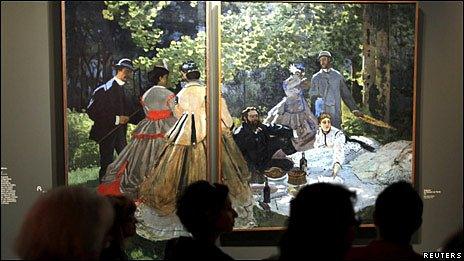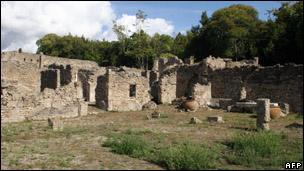How the arts are funded outside the UK
- Published

The Monet exhibition at the Grand Palais, Paris has caused great excitement in France
The UK government has announced its Spending Review, outlining its proposals to cut departmental spending.
The money given to the arts by the Department for Culture, Media and Sport was just one of the areas in the firing line, with a cut of £1.1bn over four years.
But just how does the UK compare to other countries? BBC correspondents give an overview of arts funding in India, France, Italy and the US.
INDIA: SOUTIK BISWAS, BBC NEWS, DELHI
In India, the government takes its responsibility of funding arts rather seriously. One reason is that there is very little private support for theatre, museums, dance and performing artists. So last fiscal year, the federal ministry of culture spent more than $217m (£141m) on supporting arts in the country.
By comparison, India's health budget is nearly $5bn (£3bn). In a trillion dollar economy where there is still a great pressure to deliver on fundamentals like health and education spending government money on the arts may appear to be wasteful to some people. In that context, a $217m (£138m) outlay for arts and culture may not be very paltry.
The government runs cultural centres, theatre schools, museums, libraries, and the country's main archives. It also runs two-dozen science museums. It funds expensive shows like Festivals of India which travel around the world showcasing India's culture.
There are some considerable achievements. The Delhi-based National Gallery of Modern Art has been revamped and expanded into one of the best art museums in Asia with an enviable collection of Indian art. The half-a-century old National School of Drama remains the country's leading theatre school, churning out high quality talent and plays.
The Nehru Memorial Museum and Library is arguably India's finest academic library with one of the largest collection of important papers relating to India's freedom movement and its key leaders, including its first PM Jawaharlal Nehru.
The government also runs the Central Secretariat Library with its collection of nearly two million digitised pages of government documents - one of the biggest in India. Many of the seven zonal cultural centres which showcase local fare are thriving attractions. Three well-known academies promote performing and visual arts and literature.
It is a mixed record - some of the schools, theatres, libraries and museums are run professionally, while many others suffer from neglect and lack of funds. Like most bloated government departments, a chunk of the ministry's budget is paid on employees' salaries.
Critics say ruling parties have also stacked many of these institutions with loyalists and favoured bureaucrats with no experience in the arts, making them vulnerable to political - and sometimes, ideological - pressures.
ITALY: DAVID WILLEY, BBC NEWS, ROME
For a country which claims to have the highest density of art and cultural treasures in Europe, if not the world, the current Italian government led by Silvio Berlusconi spends very little on maintaining its cultural patrimony.
Although the government frequently boasts about Italy's cultural heritage, it fails to support or preserve it. In its most recent operating budget, the government allocated only 0.28% to the culture ministry.

Pompeii is suffering the effects of a lack of investment
Due to a complicated mix of national and local subsidies for the arts, no recent overall statistics are available on per capita government expenditure on culture but in 2000 the figure was 112 euros £98. In that year, total public and private expenditure for culture amounted to around 24bn euros (£21bn) with private expenditure playing, by far, the dominant role (around ¾).
In 2008 Mr Berlusconi - Italy's wealthiest businessman as well as prime minister - decided to slash $1.3bn (£824m) from the heritage ministry's budget over the period 2008-2011. Further cuts are planned in this year's budget.
The shortfall, the government hopes, will be met by private sponsorship. But experience shows that commercial sponsors are much more interested in promoting sports, particularly football, than in encouraging the arts.
Companies receive minimal tax breaks for their contributions to culture and are more interested in promoting their products at the soccer stadium or at motor races. Museums, archaeological sites, opera houses, theatres, libraries, and film-makers all struggle to balance their budgets.
The Carlo Felice opera house in Genoa for example, refurbished at huge expense after suffering bomb damage during World War II and which reopened only in 1991, is facing closure for lack of funds.
All 13 major Italian opera houses survive mainly on subsidies from central and local government. Only La Scala in Milan, which gets the lion's share of public funding for opera, manages to offer a year round playbill featuring international stars and conductors.
Sandro Bondi, Mr Berlusconi's political party organiser who also holds the portfolio of culture minister as a second job, presides over a creaking ministry where the average age of employees is 53, and where a former head of the burger chain Mcdonald's was recruited to try to put Italy's cultural treasures on to a viable commercial financial footing.
Adding value is the buzzword at the ministry. It has not been a success. The ruined city of Pompeii is a case in point. Nearly two million visitors from around the world pay each year to tramp around the excavated remains of the imposing Roman city destroyed in a volcanic eruption in 79AD.
Weeds grow unchecked, stray wild dogs roam the ruins, and many of the frescoed houses uncovered during more than two centuries of digs are closed to the public as they are unsafe. At a recent press conference, the minister boasted that he had given added value to visitors by putting new permanent seating in the ancient theatre and bringing in electricity for stage lights to enable live performances of plays and music during the summer.
But archaeologists say they are shocked at what they regard as crass disregard for the integrity of an important and fragile 2000-year-old building. The minister seemed satisfied mainly that new homes had been found for 43 stray dogs.
US: FINLO ROHRER, BBC NEWS, WASHINGTON
Arts funding in America is, like so many other aspects of administration, a matter of both state and federal money.
There is federal funding of the arts. The National Endowment for the Arts (NEA) - headed by Broadway theatre producer Rocco Landesman - is an independent body that funds artistic and cultural work across the country.
Its budget for the fiscal year 2008-2009 was $155m (£97.5m). It makes grants based on advice from the National Council on the Arts, a body made up of artists and academics.
The NEA has found itself surrounded by controversy on occasion, and there have been concerted efforts by political opponents to abolish it completely.
Then there is a similar structure replicated in most states, which have their own arts agencies to distribute funds raised from state taxation.
The amount spent per capita varies quite significantly from state to state.
Many states' budget for the arts might seem less than lavish by UK standards.
Florida - to take one example - is second to bottom of the pile. It is spending just $950,000 (£602,000) of state money this year on competitive grants decided by panels at its Division of Cultural Affairs. This figure is down from $41m (£26m) a decade ago.
About 40% of NEA money is paid as grants to state arts agencies. Florida, for instance, received $297,000 (£188,000) in federal money this year from the NEA on top.
And the state legislature can make its own "line item" grants. These might be one-off grants to individual organisations.
Florida's total state funding per year is $0.14 per person per year. At the other end of the scale Minnesota spends $5.80 (£3.70) per person per year.
Overall, the picture is of considerably less generous government funding of the arts than in the UK.
But private benefactors can make up the gap so some US cities can enjoy world class museums, galleries, opera houses, ballet companies, symphony orchestras and theatres.
California has the lowest per capita state funding of the arts anywhere in the US. But it is also host to the J Paul Getty Museum, perhaps the wealthiest gallery in the world.
New York - which has the third best state funding - has the Solomon Guggenheim Foundation.
And there are plenty of lesser known but wealthy donors.
FRANCE: CHRISTIAN FRASER, BBC NEWS, PARIS
It takes more than an economic meltdown to curb France's enthusiasm for the arts. The new Monet exhibition at the Grand Palais is, believe it or not, the first full exhibition of his work Paris has staged in decades. The French are treating it like a national celebration.

The Louvre is flourishing but outside Paris smaller venues are feeling the pinch
The Louvre is once again claiming the title as most-visited art museum in the world and, across France, cinemas haven't been this busy since 1981. But there are cracks.
While the cultural powerhouses have flourished the smaller, more modest institutions, far from the captive audience of Paris, have had their funding budgets slashed.
Amid the gloom, President Sarkozy has installed himself as the saviour of the arts. In the March budget there was an increase in arts spending of 2.7%.
French Minister of Culture Frederic Mitterand said of the increase: "Though most of the countries of Europe have chosen to trim, often substantially, their culture budgets, France has made a different choice.
"The cultural offering is a determining element in our attractiveness as a country and its economic development."
One of the projects that is expected to benefit from the extra money is La Philharmonie, an ambitious new concert hall being constructed in Paris.
€100m (£88m) was earmarked in the culture ministry's budget for national museums and heritage sites, €750m (£660m) for a project to put books, films and museum treasures online.
But experts say look behind the headline figures and the generous subsidies they depend on are being trimmed in line with the national austerity drive.
It is perhaps a little early to see what the full effect of these savings will be on France's self-stated reputation as the cultural powerhouse of Europe.